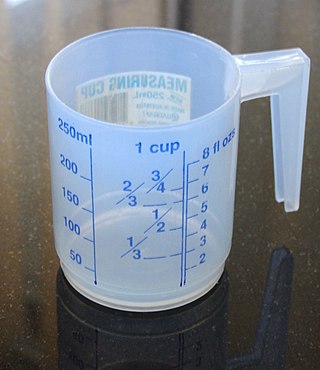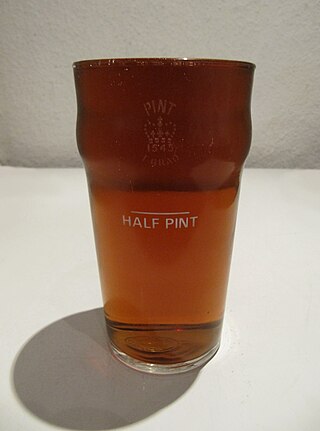Related Research Articles

The imperial system of units, imperial system or imperial units is the system of units first defined in the British Weights and Measures Act 1824 and continued to be developed through a series of Weights and Measures Acts and amendments.

The litre or liter is a metric unit of volume. It is equal to 1 cubic decimetre (dm3), 1000 cubic centimetres (cm3) or 0.001 cubic metre (m3). A cubic decimetre occupies a volume of 10 cm × 10 cm × 10 cm and is thus equal to one-thousandth of a cubic metre.

The pound or pound-mass is a unit of mass used in both the British imperial and United States customary systems of measurement. Various definitions have been used; the most common today is the international avoirdupois pound, which is legally defined as exactly 0.45359237 kilograms, and which is divided into 16 avoirdupois ounces. The international standard symbol for the avoirdupois pound is lb; an alternative symbol is lbm, #, and ℔ or ″̶.
A metric prefix is a unit prefix that precedes a basic unit of measure to indicate a multiple or submultiple of the unit. All metric prefixes used today are decadic. Each prefix has a unique symbol that is prepended to any unit symbol. The prefix kilo-, for example, may be added to gram to indicate multiplication by one thousand: one kilogram is equal to one thousand grams. The prefix milli-, likewise, may be added to metre to indicate division by one thousand; one millimetre is equal to one thousandth of a metre.

Volume is a measure of three-dimensional space. It is often quantified numerically using SI derived units or by various imperial or US customary units. The definition of length (cubed) is interrelated with volume. The volume of a container is generally understood to be the capacity of the container; i.e., the amount of fluid that the container could hold, rather than the amount of space the container itself displaces.

The pint is a unit of volume or capacity in both the imperial and United States customary measurement systems. In both of those systems it is traditionally one eighth of a gallon. The British imperial pint is about 20% larger than the American pint because the two systems are defined differently. Almost all other countries have standardized on the metric system, so although some of them still also have traditional units called pints, the volume varies by regional custom.
The oka, okka, or oke was an Ottoman measure of mass, equal to 400 dirhems. Its value varied, but it was standardized in the late empire as 1.2829 kilograms. 'Oka' is the most usual spelling today; 'oke' was the usual contemporary English spelling; 'okka' is the modern Turkish spelling, and is usually used in academic work about the Ottoman Empire.

A bushel is an imperial and US customary unit of volume based upon an earlier measure of dry capacity. The old bushel is equal to 2 kennings (obsolete), 4 pecks, or 8 dry gallons, and was used mostly for agricultural products, such as wheat. In modern usage, the volume is nominal, with bushels denoting a mass defined differently for each commodity.
The following systems arose from earlier systems, and in many cases utilise parts of much older systems. For the most part they were used to varying degrees in the Middle Ages and surrounding time periods. Some of these systems found their way into later systems, such as the Imperial system and even SI.

The Dutch units of measurement used today are those of the metric system. Before the 19th century, a wide variety of different weights and measures were used by the various Dutch towns and provinces. Despite the country's small size, there was a lack of uniformity. During the Dutch Golden Age, these weights and measures accompanied the Dutch to the farthest corners of their colonial empire, including South Africa, New Amsterdam and the Dutch East Indies. Units of weight included the pond, ons and last. There was also an apothecaries' system of weights. The mijl and roede were measurements of distance. Smaller distances were measured in units based on parts of the body – the el, the voet, the palm and the duim. Area was measured by the morgen, hont, roede and voet. Units of volume included the okshoofd, aam, anker, stoop, and mingel. At the start of the 19th century the Dutch adopted a unified metric system, but it was based on a modified version of the metric system, different from the system used today. In 1869, this was realigned with the international metric system. These old units of measurement have disappeared, but they remain a colourful legacy of the Netherlands' maritime and commercial importance and survive today in a number of Dutch sayings and expressions.
The units of measurement of German-speaking countries consist of a variety of units, with varying local standard definitions. While many were made redundant with the introduction of the metric system, some of these units are still used in everyday speech and even in stores and on street markets as shorthand for similar amounts in the metric system. For example, some customers ask for one pound of something when they want 500 grams.

The earliest recorded systems of weights and measures originate in the 3rd or 4th millennium BC. Even the very earliest civilizations needed measurement for purposes of agriculture, construction and trade. Early standard units might only have applied to a single community or small region, with every area developing its own standards for lengths, areas, volumes and masses. Often such systems were closely tied to one field of use, so that volume measures used, for example, for dry grains were unrelated to those for liquids, with neither bearing any particular relationship to units of length used for measuring cloth or land. With development of manufacturing technologies, and the growing importance of trade between communities and ultimately across the Earth, standardized weights and measures became critical. Starting in the 18th century, modernized, simplified and uniform systems of weights and measures were developed, with the fundamental units defined by ever more precise methods in the science of metrology. The discovery and application of electricity was one factor motivating the development of standardized internationally applicable units.
The traditional Polish units of measurement included two uniform yet distinct systems of weights and measures, as well as a number of related systems borrowed from neighbouring states. The first attempt at standardisation came with the introduction of the Old Polish measurement [system], also dubbed the Warsaw system, introduced by a royal decree of December 6, 1764. The system was later replaced by the New Polish measurement [system] introduced on January 1, 1819.

The hectare is a non-SI metric unit of area equal to a square with 100-metre sides (1 hm2), or 10,000 m2, and is primarily used in the measurement of land. There are 100 hectares in one square kilometre. An acre is about 0.405 hectares and one hectare contains about 2.47 acres.
A number of units of measurement were used in Nicaragua to measure measurements in mass, area, volume, etc. In Nicaragua, the metric system was adopted in 1910, and has been compulsory since 1912, by a joint convention between Costa Rica, Guatemala, Honduras, Nicaragua and El Salvador.
A number of different units of measurement were historically used in Cyprus to measure quantities like length, mass, area and capacity. Before the Metric system, the Imperial system was used. In between 1986-1988, metric system was adopted in Cyprus.
A number of units of measurement were used in Egypt to measure length, mass, area, capacity, etc. In Egypt, the metric system was made optional in 1873 and has been compulsory in government use since 1891.
A number of units of measurement have been used in Cambodia to measure length, mass, volume, etc. The metric system has been compulsory there since 1914.
A number of different units of measurement were used in Libya to measure length, mass, area, etc. The metric system was adopted in Libya in 1927.
References
- 1 2 3 4 5 6 7 8 9 Washburn, E.W. (1926). International Critical Tables of Numerical Data, Physics, Chemistry and Technology. New York: McGraw-Hil Book Company, Inc. p. 8.
- 1 2 3 4 5 6 7 8 Cardarelli, F. (2003). Encyclopaedia of Scientific Units, Weights and Measures. Their SI Equivalences and Origins . London: Springer. pp. 95, 96. ISBN 978-1-4471-1122-1.
- 1 2 3 4 5 6 7 8 Nikolantonakis, K (September 6–9, 2006), Weights and measures: The Greek efforts to integrate the metric system, Cracow, Poland: The Global and the Local: The History of Science and the Cultural Integration of Europe. Proceedings of the 2nd ICESHS, pp. 457–459
- 1 2 3 4 Clarke, F.W. (1891). Weights Measures and Money of All Nations. New York: D. Appleton & Company. pp. 39.